
Inspiring Smiles Forever

Complete Works, Portraits, Landscapes, Still Lifes, Sculpture, Lego Artist...
Sign up for yearly notices by sending an e-mail to newart-subscribe@tomlohre.com
Post comments on https://www.facebook.com/artisthos/
With the upscale tenants comes a stronger block association and that means Christopher Street will be tamed down. With people paying eight hundred dollars for a small apartment right on the river don't want to contend with a large group of gay men drinking beer from paper bags and milling about. The people living on Christopher Street didn't have anything to do with its becoming the gay street. At first it was hard to accept getting spit at and harassed being a straight couple walking down Christopher Street. Then people started accepting one another which started getting a more younger gay crowd. But that led to the poorer gay men spending more and more time milling about on the street. Voguing started then from boys standing around dishing one another. Black Madonna was murdered because of this phenomenon. The pier just got too dangerous. Christopher Street is now really ethic gay New York and it's going to stay that way. Tom lived at 89 Christopher Street #2 for twenty years from 1976 to 1996. The first several years he worked on Madison Avenue in advertising. After producing several master works in oil painting he left Madison Avenue. Tom filled ten sketch books during this period. More were lived in the beginning while Tom was learning. The sketches here were in Tom's second from last sketch book. There are still a few pages left in the back. During this period Tom was working in Greenville, South Carolina for a year on several commissions and would from time to time return home to NYC. He finally finish work in Greenville and spent his last full summer in New York City in 1991. Tom spent much of his time on the road spending summers in Nantucket and winters in Palm Beach before getting married and moving back to his hometown of Cincinnati, Ohio.
Nelson Sullivan & Blackie by Tom Lohre, 30” x 40”, Oil on canvas, 1989
FORT GANSEVOORT 5 Ninth Avenue, NYC, 10014 | gallery@fortgansevoort.com |
(917) 639 - 3113
A Look Back: 50 Years After Stonewall
Opening On: Thursday, June 27, 6 – 8 PM June 27 – July 27, 2019
http://www.fortgansevoort.com/
Fort Gansevoort presents A Look Back: 50 Years After Stonewall, organized
by Lucy Beni and Adam Shopkorn. The exhibition commemorates the fiftieth anniversary
of the 1969 Stonewall Uprising, a six-day riot said to have been spontaneously
set off by Marsha P. Johnson in protest of one of many regular police raids
at The Stonewall Inn, a gay bar located in New York City’s Greenwich
Village. This event marks the beginning of the Gay Liberation movement and
the contemporary fight for LGBTQ+ rights in the United States.
A Look Back: 50 Years After Stonewall unites the work of queer artists living
and producing in and around New York City beginning around the time of the
Stonewall Uprising in 1969 and leading into the 1980s. This is only a portion
of the story, an incomplete history, most especially given that the Gay Liberation
movement and its coinciding contemporary art market had not placed transgender
voices nor people of color at the forefront of the conversation. The exhibition
includes both documentation of the Gay Liberation movement and a look back
at the work made by LGBTQ+ artists during this time. Central to the work included
are the subjects of protest, revolt, celebration, and love. Kate Millett’s
sculpture, American Flag Goes to Pot (1970) provides a blunt protest to government
authority, while Joan E. Biren’s photograph’s document the tenderness
of love between two women. The work made during the beginning of the AIDS
epidemic, beginning in 1981, becomes entangled in death and remembrance, an
epidemic defining this decade most especially in the New York City queer community
and resulting in a tremendous amount of loss. Peter Hujar, Paul Thek and David
Wojnarowicz’s work all reflect this tragic time. Highlighted in the
exhibition is the work of Nelson Sullivan, who throughout the 1980s lived
at 5 Ninth Avenue where Fort Gansevoort is now located. Sullivan passed away
in 1989. Nelson Sullivan documented queer New York City in the 1980s through
a dedication to filming everything. His videos focus largely on his neighborhood
and the downtown nightlife scene; one full of life and color and regularly
including personalities such as RuPaul, Sylvia Miles, Michael Musto, Dean
Johnson, Ethyl Eichelberger, and Lady Bunny. A selection of Sullivan’s
many videos in and around his home in the Meatpacking District are included
in the exhibition. The third floor of the exhibition pays respect to Sullivan’s
legacy through a collection of photographs taken by his friends and a painted
portrait of Sullivan himself, momentarily returned to its original home at
5 Ninth Avenue. Featured artists in the exhibition include Joan E. Biren,
Jimmy DeSana, Rotimi Fani-Kayode, Flloyd, Efrain John Gonzalez, Barbara Hammer,
Harmony Hammond, Lyle Ashton Harris, Peter Hujar, Thomas Lanigan-Schmidt,
Greer Lankton, Tom Lohre, Kate Millett, John Simone, Nelson Sullivan, Paul
Thek, Paula Gately Tillman, David Wojnarowicz, Martin Wong among others. Also
included in the exhibition is ephemera such as pride and protest buttons,
Tee Corinne’s 1975 Cunt Coloring Book, and the 1970s lesbian newspaper
The Furies.
Entrance to 3-Mile Harbor, 16" x 12, Oil on board, August 2007
South Street Seaport, New York City, 40" x 30", prints available
/waverlyB.jpg
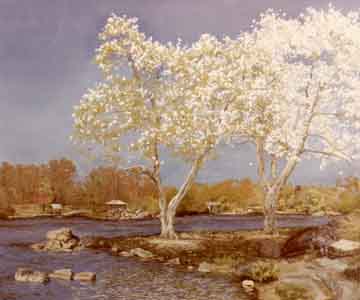
Central Park, New York City, 24" 20", oil on canvas, May 1978, painted from life for the aunt and uncle of a girlfriend.
Perry Street, Greenwich Village, New York City, 8” X 10”, Oil
on canvas, October 10, 2005
Tom lived in Greenwich Village for twenty years from 1976 to 1996. During
that time he started working kin advertising on Madison Avenue and in 1979
started working full time as an artist painting portraits and scenes. Trained
as a formal portrait painter by portrait painter R_ and working solely as
one for the beginning of his career, Tom slowly began painting in the streets
of New York City. This painting is one he did while visiting his old haunts
in the Village. A gingko tree in the fall still in foliage on the left and
a small sign for a country cabin real-estate service on the right. http://www.theruralconnection.com/
Painted at night.
Empire State Building III, Finished Friday, March 30, 2012, 5" x 7" x .125” x 2 oz., Oil pastel melted on Plexiglas. Framed in a Neapolitan style simulated gold leaf over clay over wood with no seam in corners weighing 2 pounds
Empire State Building II, Finished Friday, March 30, 2012, 5" x 7" x .125” x 2 oz., Oil pastel melted on Plexiglas. Framed in a Neapolitan style simulated gold leaf over clay over wood with no seam in corners weighing 2 pounds
Empire State Building I, Finished Friday, March 30, 2012, 5" x 7" x .125” x 2 oz., Oil pastel melted on Plexiglas. Framed in a Neapolitan style simulated gold leaf over clay over wood with no seam in corners weighing 2 pounds
Li Lac Chocolates I, New York City, Oil on canvas, 12" x 16", October 28, 1995
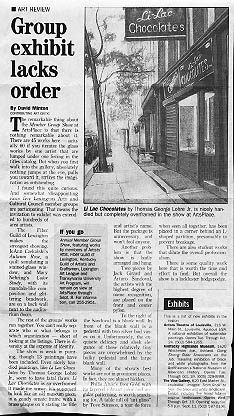
Article appeared in the Lexington Herald Leader August 30th, 1995 when the Lic Lac painting was in a group show of the Lexington Art league
Stoney Brook, Long Island, New York, 16" x 12", oil on board, September
3, 2007, painted from life while attending George's wedding. Tom and his brother
Chuck drove up from Cincinnati, stopping in Stoney Brook, New York to pick
up an antique Volvo sedan to make the rest of the trip out the island. The
car played a pivotal part in the celebrations since George owned one that
is in Germany. This view is the public beach in Stoney Brook. You can see
the floats and cans surrounding the swimming area but not the shelter of the
public area. In the background the homes of Stoney Brook lined the shoreline.
You can see the green and red buoys marking the channel out to Long Island
Sound.
This painting is done in the traditional way painting a medium of half Dammar
varnish and half stand oil tinted with oil paint on scrapped smooth gessoed
Masonite board. Tom used a rubber tipped brush to remove paint revealing the
gessoed board behind. You can see the use of the rubber tipped brush in the
trees on the right. Tom’s paint box was remade allowing for four wet
boards to be stored in a slotted holder that is inserted in the lid of the
paint box. Over the years Tom’s paint boxes go over major overhauls
to accommodate his needs. The box used for this painting is large enough to
hold 16” x 12’ paintings inside. His other box holds 20”
x 16.” Over time they become more assembled with epoxy and wood strips
that support the box. Going through check in at the airport can be a dramatic
experience. No mineral spirits or turpentine is allowed and all tools have
to be less than seven inches long. Tom fondly remembers when he lost his prized
palette knife because it was too long. He is still looking for a replacement.
An artist’s palette knife and his maul stick are lifelong friends. A
maul stick is a wooden dowel with a wooden ball at the top, used to rest on
the edge of the canvas to steady the artist’s hand and draw straight
lines.
3 Mile Harbor, East Hampton, New York, 16" x 12", oil on board,
September 4, 2007, Painted from life while attending George and Susanne’s
wedding. Tom had sailed out of the marina many times over the last ten years
on George’s 26 foot Pearson sailboat. Now, George was in the process
of rebuilding a thirty six foot Pearson. The sailboat along with several other
power boats took the wedding party to an island for the vows. The island is
a spit of land exposed mostly at low tide. Tom and his brother Chuck drove
out to the marina in Tom’s friend Paul’s Volvo sedan exactly like
the one George owned. It was fun to shuffle George’s mother about in
classic Hampton manner. Tom also brought the portrait of George’s family
unfinished for some sittings. The painting suffered some damage in transit
but the final painting is an excellent example of Tom taking a masterpiece
from the Cincinnati Art Museum and replacing the people with George’s
wife and two sons as the Blessed Virgin, Jesus and Saint John the Baptist.
The view out Three Mile Harbor is not unlike all such bays in the region.
Low lying hills flanking an expansive sky and endless level water framed with
sea grass with gray vacation homes peeking out from the perimeter of the meeting
of the sea and sky. Only a few buoys and stationary fishing boats identify
the unique sense of this end of the bay. Only one more marina is just behind
this one.
This painting is done in the traditional way, scraping gesso over the Masonite
until the surface is smooth then painting a tinted medium of half stand oil
and half Dammar varnish. A lot of dirt is in the painting since it was windy.
The gray band along the horizon is a cloud bank. The upper clouds are ice
cloud mares tails.
The marina is a funky place like Sanford and Sons junk yard. Don the owner
is a larger than life person who knows all about machinery. He runs the place
as a hobby. Tom has been going to the marina since 1989 when he sailed into
the harbor from the Chesapeake. One of his patrons was moving his thirty foot
sail boat up from the bay. Tom had got to know him in New York City a close
friend of his patron Birdie Block.
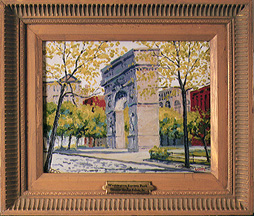
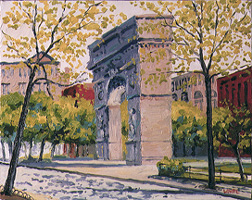
Washington Square Arch, 10" x 8", Oil on canvas
Irving Berlins Home Oil on canvas, 10 x 8, October 1996 Painted from life in the upper east side of New York City. Now the home of the Ducy of Luxembourg. Tom was staying in a hotel nearby while his wife attended a professional meeting and made use of the splendid opportunity to work in the fancy Sutton Place neighborhood. The home was previously owned by Irving Berlin for many years. Tom knows John Wallowitch, a composer like Berlin, who lives just down the street. Every Christmas Eve John and his friends would sing Christmas carols outside his home. Sometimes Irving would come to the window. While working on the painting for several days Tom felt quite safe in the ritzy, glitzy neighborhood. A proverbially whos who of American and European wealthy would walk by and it was one of the few places where Tom felt he could leave his paint stand for a few minutes to go down the street to get a sandwich. Several people expressed a lot of interest in the painting while he worked on it as the leaves fell from the Ginkgo trees that grow plentiful in the city. It is said that the Ginkgo tree is a prehistoric tree that was capable of surviving volcanic eruptions and the massive pollutants that come with such eruptions so is perfectly suited for growing in the polluted city. Tom had painted many such paintings on the street but worked especially hard on this one because he was slowly moving out of the apartment he lived at for twenty years in Greenwich Village and was moving to Cincinnati, Ohio, where his wife worked and his hometown. The composition of the painting is a variation of Toms tunnel view down city streets. In this view the street ends as the cliff begins dropping down a hundred or so feet to the East River. The color is indicative of Toms strong light and dark manner where the two light fluxes are juxtaposed against each other. The dark shadow areas are full of variation as well as the light areas but when a photo is taken of the painting the two areas cannot be reproduced correctly. Either the light or the dark area has to be focused on for the light flux difference is so great, very much like human vision. Tom used his yellow light and blue shadow manner. Changing the color of the light and dark areas to lean towards a stronger color gives piazza to the paintings.
Queensboro Bridge, Oil on canvas, 16” x 12”, Fall 1996, Commission, later the commisioner had Tom paint out the family on the left and add her girl friend
Sanpops Store, Perry Street, Greenwich Village
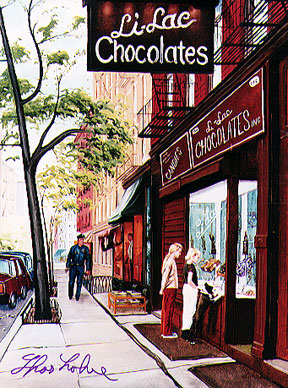
Village Delight, Oil on canvas, 16" x 20", Spring 1996
Painted from life, one of the last paintings done before giving up his NYC apartment of twenty years. It was the time where showing in coffee shops was popular and this place as a shoe in for Tom. He distributed coupons during the opening for $2 off whatever his guests wanted. For the rest of the week he painted this view. The players are all characters and much in the way of a local neighborhood, happenings occurred.
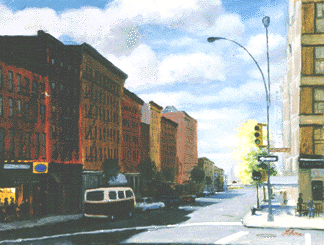
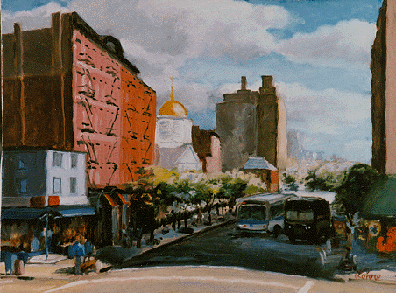
This view shows Tom's old apartment building, the one he lived in for twenty years from 1978 to 1998. Only the delivery trucks and buses occupy the street. The local citizens have their automatic wheel chairs along with the blind girl & seeing eye dog.
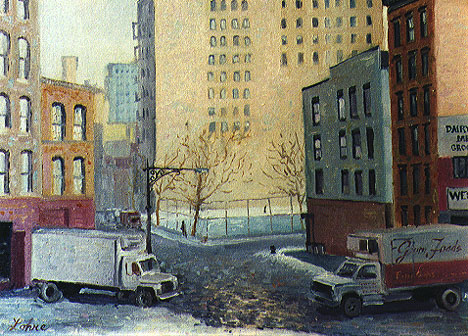
West Ninth Street, Oil on canvas, 16" x 12", May 30, 1988
Village Cigars, Oil on canvas, 20" x 16", April 20, 1989, No image
Village Cigars, Oil on canvas, 20" x 16", April 20, 1989, No image
Below are some of the 29 illustrations.

Alan Ginsberg,
Black Marsha,
The Stonewall Inn, located at 51 Christopher Street, first opened its door in the Depression year of 1930, having been converted from two hundred-year-old stables. Utilized for several decades as a hall for private parties, business banquets, and weddings celebrations, in the decade of the sixties it became a tawdry gay bar frequented by preppie types and drag queens like. A callboy service sometimes operated on the second floor. On the evening of June 28th, 1969, it became the improbable site of the Battle of Stonewall during a police raid of the place. Robert Bryan, a mens fashion magazine editor, was there that night and remembers policemen being driven back by angry drag queens tired of being intimidated and oppressed by John Law. A prominent solider in the melee was Black Marsha (a.k.a.) Marsha P. Johnson or Malcolm Michaels), a black drag queen and panhandling Christopher Street personality for over twenty years. Read the full story in Greenwich Village, a primo guide by John Gilman and Bob Heide from St. Martins press. Tom Lohre did the 27 paintings for the guide. Tom lived on Christopher Street for twenty years.
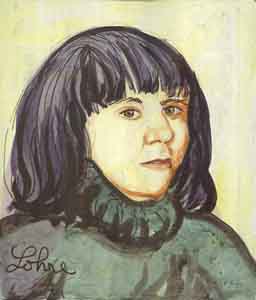
Crystal Field
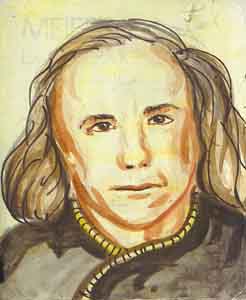
George Bartenieff
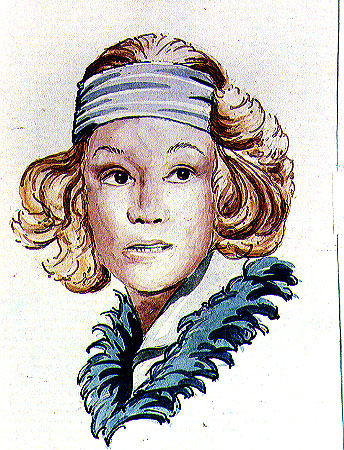
Sylvia Miles
Bob Dylan
Young Edward Albee
Tiny Tim
Walt Whitman
Thomas Paine
Sylvia Miles
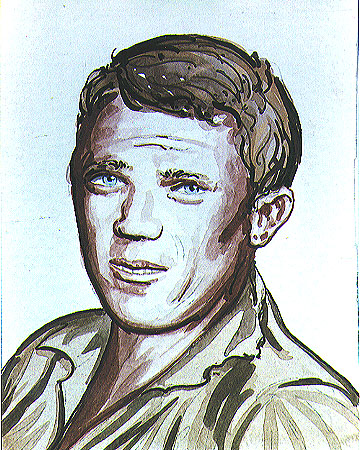
Steve McQueen, Watercolor on painted 40oz beer label
with the top cut off,
Sam Shepard, Watercolor on painted 40oz beer label
with the top cut off,
Maxwell Bodenheim, watercolor on painted 40oz beer
label with the top cut off,
Mattheu Bodine, watercolor on painted 40oz beer label
with the top cut off,
John Wallowitch, watercolor on paper, 5 x 7, June
15th, 1992, no image
Jimmy Hendrix, watercolor on painted 40oz beer label with the top cut off, 3 x 3 x 6, June 14, 1992, no image
James Dean, watercolor on painted 40oz beer label with the top cut off, 3 x 3 x 6, June 13, 1992, no image
Henry James, watercolor on paper, 5 x 7, June 12, 1992, no image
Eleanor Roosevelt, watercolor on painted 40oz beer label with the top cut off, 3 x 3 x 6, June 6, 1992, no image
Edward Albee III, watercolor on paper, 5 x 7, June 4, 1992
Edward Albee II, watercolor on paper, 5 x 7, June 3, 1992, no image
Edward Albee I, watercolor on paper, 5 x 7, June 2, 1992, no image
Edna St.Vincent Millay,
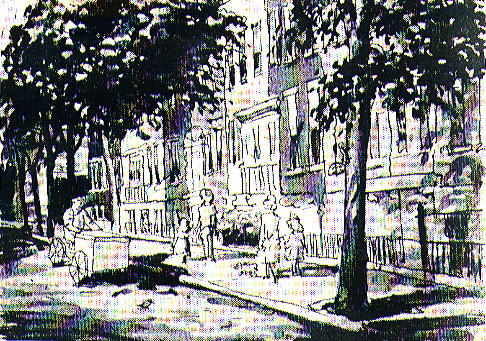
MacDougal Street, pen on paper, 7” x 5” , May 1, 1992
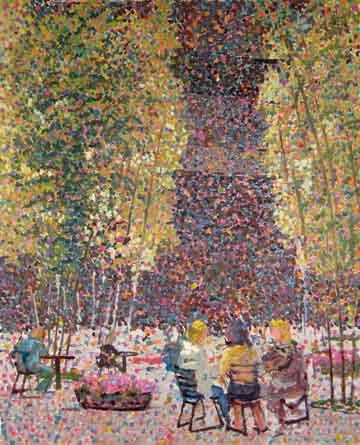
AT&T Office Atrium, 16" x 20", Oil on canvas
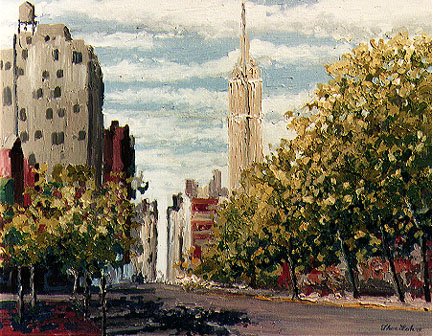
Father Demos Square,
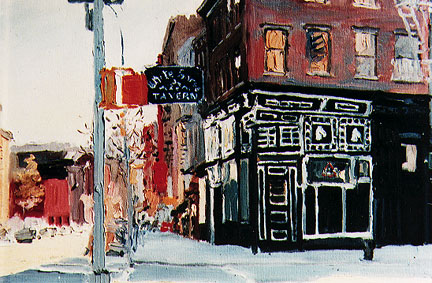
White Horse Cafe, Oil on canvas, 16” x 12” , April 1, 1989
Washington Square,
Brant’s Band,
Waverly Theatre,
Sheridan Square with Four People on left, Oil on canvas, 10" x 8", September 3, 1988, no image
Village Cigars with Woman and Black Man, Oil on canvas, 10" x 8", September 2, 1988, no image
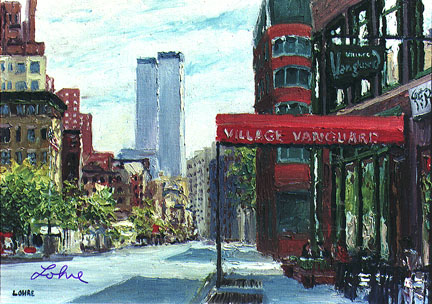
Village Vanguard, Oil on canvas, 16” x 12”, October 10, 1987
Village Cigars, Oil on canvas, 10" x 8", June 15, 1987, no image
Fifth Avenue, Oil on canvas, 16” x 12”, May 1, 1987, no image

Commerce Street, New York City, Oil on canvas, 16” x 12”, Winter 1987
7th Ave South, New York City, September 6, 1987, Oil on canvas, 24" x 20"
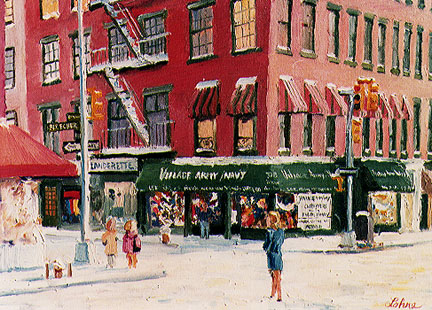
Army Navy Store, Oil on canvas, October 30, 1987
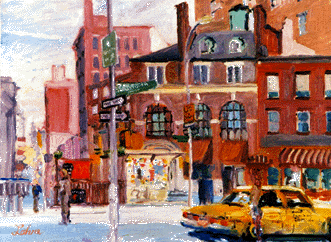
Chemical Bank, Oil on canvas, 16" x 12", May 1, 1987
One of the finest examples of Tom's impressionistic work. So strong is this painting that it needs the frame it hangs in. The scene is a normal dirty dusty view from mid-Manhattan but the use of color makes it become more than it is.Tom lived on the street where the painting was done. He set up his easel in front of the famous Village Cigars and worked there for several days. As you might imagine, there were hordes of people moving around him and some felt that they were put out.
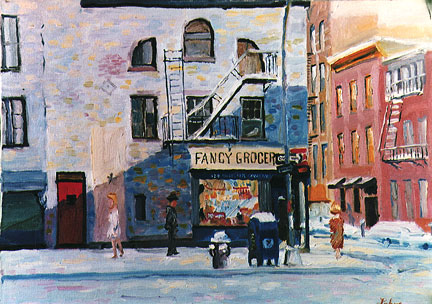
Fancy Grocery Store, Oil on canvas, 16" x 12", Winter 1987
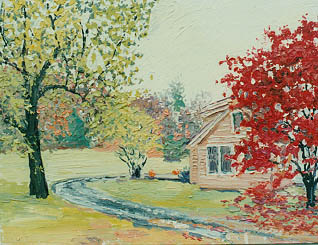

Cherry Lane Theatre, Oil
on canvas, 10” x 8”, May 1st, 1986
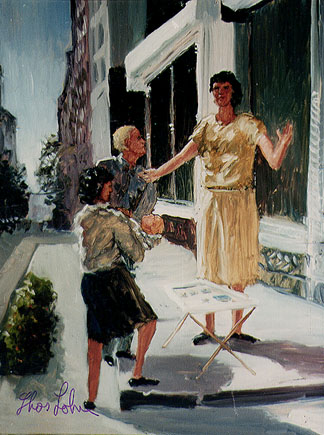
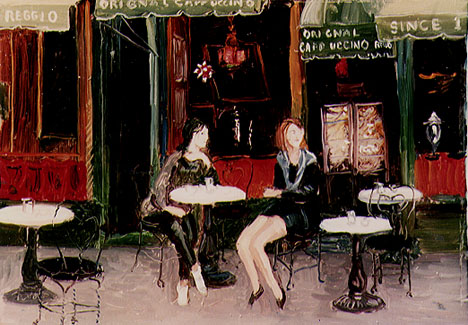
Dante’s Cafe, Oil
on mylar, 10” x 8”, June 1st, 1985
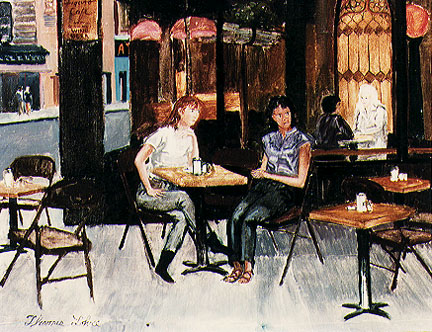
Central Park, Oil on canvas,
24” x 20”, June 15th, 1979
Cadillac, 18" x 14", oil on board, 1977Painted from life outside Bearsville Recording Studio, Woodstock New York. At the time Tom was dating a Rock and Roll singer. As she spent several days inside working on her new album he sat outside and painted views from the parking lot.
Monte Carlo Nude Pencil on paper, 8" x 10.5", 1991, available
Sketched from life during a portrait commission in Monte Carlo. This may have been the selected composition. The subject was drawn in the nude for novel reasons. She was never intended to be nude, it just made for a good sketch.
Museum Nude Pencil on paper, 10.5" x 8", 1991, available
This drawing was sketched from life in the Cincinnati Art Museum. It was just before Tom left for Europe. He was painting two portraits in Monte Carlo. Tom feels that sketches like these firm up in your mind what it is that you are looking at while you look at it.
Monte Carlo Date, available
Pencil on paper, 8" x 10.5", 1991This drawing is rough composition for a portrait of a casino winner.
Brooklyn Bridge, New York City, available
Pencil on paper, 10.5" x 8", 1991This drawing was sketched from life from a small park across the East River. The composition was part of some research drawings done for a commission.
Croquet in Central Park I, available
Pencil on paper, 10.5" x 8", 1991This artwork was drawn from life during a gray day in upper Central Park on the West side where there are several croquet courts. The players normally dress in white.
Croquet in Central Park II, available
Pencil on paper, 10.5" x 8", 1991This drawing was sketched from life.
Earth Day 1991 Pencil on paper, 8" x 10.5", 1991This drawing was done in Tom's apartment on Christopher Street, New York City on Earth Day. Tom has done several other still life's with Earth Day themes.
Ellen Pencil on paper, 10.5" x 8", 1991, sketched from life.
John Wallowitch TV Show, Pencil on paper, 10.5" x 8", 1991This drawing was sketched from life. Tom was a cameraman when present on the set. John's show is still on as a local cable call in show.
Museum Nude II Pencil on paper, 10.5" x 8", 1991, sketched from life in front of the painting.
Christopher Street Pier, New York City, Pencil on paper, 10.5" x 8", 1991, Sketched from life. Tom was working on a great oil painting of New York City Harbor.
Rivera Cafe, Greenwich Village, NYC, Pencil on paper, 10.5" x 8", 1991, sketched from life from Sheridan Square Park just at the crossroads of Seventh Avenue and West 4th Street.
Sheep Meadow, Central Park, New York City, Pencil on paper, 10.5" x 8", 1991, sketched from life.
Subway Line-Up,Pencil on paper, 8" x 10.5", 1991, sketched from life in the New York City Subway.
Village Cigars Pencil on paper, 10.5" x 8", 1991, A venerable store smack dab in the center of Greenwich Village. This drawing was sketched from life from the park across the street. Tom has drawn and painted this view many times.
Monte Carlo Gaming Table I Pencil on paper, 8" x 10.5", 1991, sketched from life.
Monte Carlo Gaming Table II, Pencil on paper, 8" x 10.5", 1991, sketched from life from the edge of the gamming tables in Monte Carlo. Tom was able to do two such sketches before he was asked to stop by casino guards.
Museum Study Pencil on paper, 10.5" x 8", 1991, sketched from life in front of an oil landscape painting in a museum. Tom began his study of art by copying paintings in museums.
View Locations
of Paintings from Life in a larger map.
Experience The Warm Feeling of Owning Original Art
Click To Contact Inspiring Smiles Forever
Look to these pages for the latest from the studio and the boat yard. This is a simple web site with no cookies or security hosted by Go Daddy. Trust they will let you have fun browsing.
Complete Works, Portraits, Landscapes, Still Lifes, Sculpture, Lego Artist...
Click To Sign up for auction notices or check past auction sales at EBTH
Have any Tom Lohre painting on Prints, Greeting Cards, Throw Pillows, Duvet Covers, Shower Curtains, Tote Bags, iPhone Cases, T-Shirts, Round Beach Towels, Towels (Beach & Bath), Yoga Mats, Spiral Notebooks, Fleece Blankets, Portable Batteries Chargers, Carry-all Pouches, Weekender Tote Bags, Coffee Mugs, Tapestries, Face Masks, Jigsaw Puzzles, Stickers and Oraments via Fine Art America
If you don't see your favorite painting request it to be offered.
Post comments on Facebook https://www.facebook.com/tom.lohre/
Tom's sailing page Stories of 4 Atlantic crossings, boat rebuild, sailing on the Ohio River and links to PDF and videos
Online Clifton Chronicle The local publication Tom was the editor for ten years.
Special Web Sites, Family Tree, Friend's Links
11223 Cornell Park Dr. Suite 301, Blue Ash, Ohio 45242